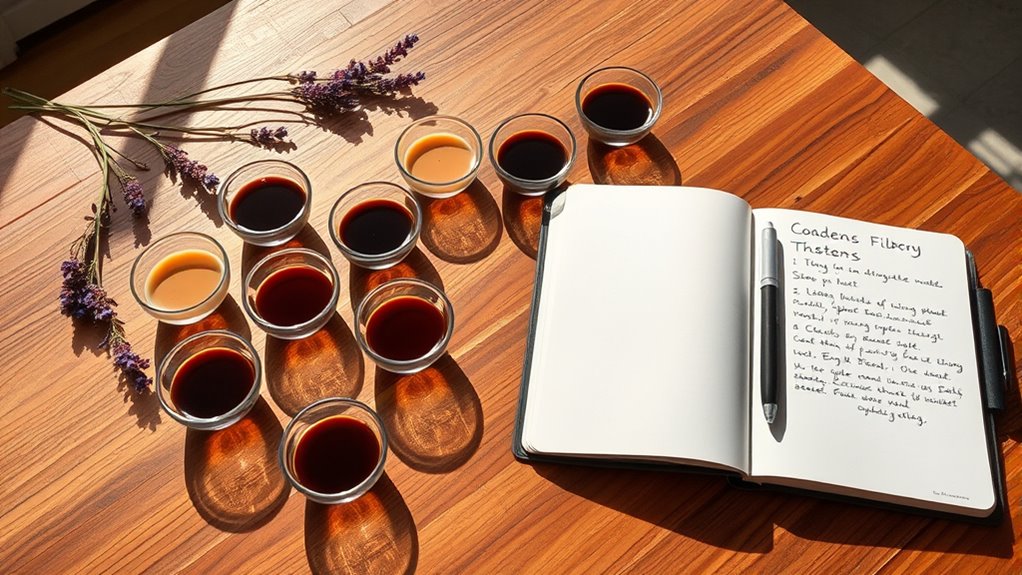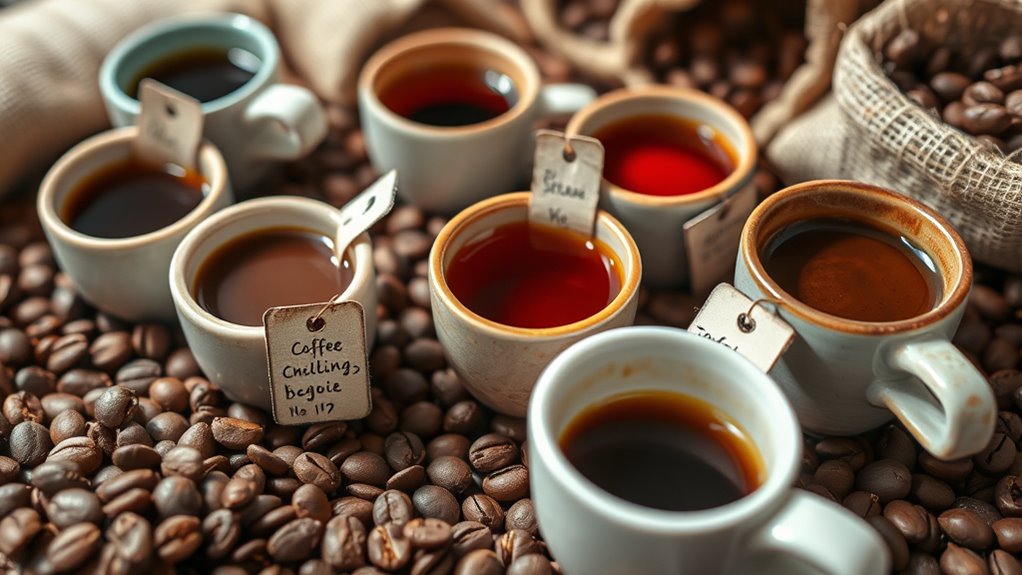To train your palate for coffee tasting, start by understanding its complex flavors and aromas. Engage in active tasting, focusing on sweet, sour, salty, bitter, and umami notes. Keep a coffee journal to document flavors and preferences, and build a personal flavor library with non-coffee foods. Practice mindful tasting and explore various brewing methods to refine your skills. With consistent effort, you’ll enhance your appreciation for coffee’s richness, and there’s even more to discover ahead.
Key Takeaways
- Engage in active tasting by evaluating sweetness, acidity, and bitterness to uncover rich coffee flavors.
- Build a personal flavor library by documenting non-coffee foods to enhance flavor recognition.
- Keep a coffee journal to log tasting experiences, brewing methods, and evolving flavor preferences.
- Conduct blind tastings to eliminate biases and evaluate flavors honestly.
- Utilize resources like the Specialty Coffee Association flavor wheel for precise flavor descriptors and guidance.
Understanding the Basics of Coffee Tasting

When you immerse yourself in coffee tasting, you’ll discover that this experience is as rich and complex as the beverage itself.
Coffee boasts over 800 unique aromatic compounds, each contributing to a vast array of flavors and aromas. To understand these, start with the five basic tastes: sweet, sour, salty, bitter, and umami. They’re essential for identifying flavor profiles.
Utilize the coffee flavor wheel from the Specialty Coffee Association of America to categorize your findings. Keeping a coffee journal can further enhance your palate development by logging your observations and tasting experiences.
With consistent practice, you’ll refine your ability to analyze qualities like sweetness, acidity, and bitterness, deepening your appreciation for specialty coffee.
Engaging in Active Tasting Practices

To truly appreciate coffee, you need to engage in active tasting practices that sharpen your palate and deepen your understanding of its flavors. Start by evaluating the basic tastes—sweet, sour, salty, bitter, and umami—in each cup.
Engage in active tasting to refine your palate and uncover the rich flavors of coffee.
Experiment with different foods while tasting, as this enhances your ability to identify flavors and aromas. Mindful tasting helps you focus on coffee’s acidity, body, and finish, leading to valuable insights about its complexities.
Consider keeping a coffee journal to document your experiences and reflections, which promotes continuous improvement in your palate development.
Additionally, conducting blind tastings can eliminate biases, allowing you to evaluate flavors honestly and enhance your skills as a coffee drinker. Engaging in these practices makes all the difference.
Creating a Personal Flavor Library

Building a personal flavor library enriches your coffee tasting experience, as it helps you identify and appreciate the myriad flavors within each cup. To develop your palate, actively taste different types of non-coffee foods like fruits and candies. Document your observations in a coffee journal, noting unique flavors and tasting notes.
Here’s a simple framework to help organize your flavor library:
| Flavor Type | Example | Notes |
|---|---|---|
| Citrus | Lemon | Bright, tangy |
| Chocolate | Dark | Rich, sweet |
| Floral | Jasmine | Fragrant, delicate |
Documenting Your Coffee Journey

Keeping a coffee journal is a great way to log your tasting experiences and track your flavor progress.
By noting specific flavors and brewing methods, you can sharpen your palate and better articulate what you enjoy.
Regularly revisiting your entries helps you recognize patterns in your preferences and enhances your overall coffee journey.
Tasting Notes Journal
As you explore the world of coffee tasting, a journal can become your most valuable companion on this flavor exploration.
A tasting notes journal allows you to log different coffees, detailing their origin, roast level, and specific flavors. This practice helps you actively engage with aromas and flavors, enhancing your coffee palate over time.
Consider including:
- Descriptions of flavor notes and aromas you detect.
- Observations about how different brewing methods affect taste.
- Personal reflections on your evolving preferences.
Flavor Progress Tracking
Tracking your flavor progress through a coffee journal is a rewarding way to document your tasting journey. By noting the different coffee you taste, you can enhance your well-developed palate. Regular entries encourage active thinking about flavor profiles and brewing methods, making it easier to identify patterns in your experiences.
Here’s a simple format to get you started:
| Coffee Type | Flavor Notes | Brewing Method |
|---|---|---|
| Ethiopian Yirgacheffe | Floral, Citrus | Pour-over |
| Colombian Supremo | Nutty, Chocolate | French Press |
| Sumatran Mandheling | Earthy, Spicy | Espresso |
| Guatemalan Antigua | Sweet, Cocoa | AeroPress |
Revisiting your notes helps you reflect on how your palate evolves and your sensitivity to flavor notes improves.
Exploring Flavor Descriptors

How do you truly appreciate the complexity of coffee? By exploring flavor descriptors, you can distinguish between different tastes found in coffee beans.
Utilizing resources like the Specialty Coffee Association flavor wheel or the World Coffee Research Sensory Lexicon helps you articulate your tasting experiences with precision.
Here are some ways to enhance your coffee tasting:
- Engage with expert tasters’ notes to understand flavor nuances.
- Build a personal flavor library by tasting various non-coffee foods.
- Use tools like the Aroma Kit Coffee Flavor Map T100 for visual flavor guidance.
- Additionally, coffee contains antioxidants that can enhance flavor complexity and overall tasting experience.
Expanding Your Coffee Tasting Experience

Expanding your coffee tasting experience opens up a world of flavors and aromas that can transform your appreciation for this beloved beverage. Pay attention to different origins and regularly sample various roasts; this exposure helps you distinguish unique flavor profiles.
As you sip your coffee, try pairing it with diverse foods like fruits or candies to build a flavor library. Tools like the Aroma Kit and Taster’s Wheel can familiarize you with common coffee flavors, enhancing your descriptions.
Keep a coffee journal to log your tasting experiences and track your palate development. Participating in group tastings or workshops will provide comparative insights and tips to help you learn from others, enriching your overall coffee appreciation.
Frequently Asked Questions
How to Train Your Palate for Coffee?
To train your palate for coffee, start by tasting a variety of origins and roasts.
Focus on identifying sweet, sour, salty, bitter, and umami flavors in each cup.
Keep a journal to log your experiences and track your progress.
Use a flavor wheel to expand your vocabulary, and practice smelling different items to enhance your sensory skills.
Engage in tasting sessions with others to gain new insights and broaden your flavor recognition.
How to Cleanse Your Palate for Coffee Tasting?
You know what they say: “Out with the old, in with the new.”
To cleanse your palate before tasting, start by sipping room temperature water to avoid dulling your taste buds. Munch on plain crackers or bread to absorb lingering flavors.
Steer clear of strong foods that might overwhelm your palate, and consider a piece of apple or celery for a revitalizing cleanse.
Wait 15-30 minutes after eating to verify your palate’s ready for a fresh experience.
How to Train Your Taste Palate?
To train your taste palate, start by actively tasting a variety of foods, like fruits and candies, to expand your flavor library.
Familiarize yourself with basic tastes—sweet, sour, salty, bitter, and umami—using solutions like sucrose and citric acid.
Keep a journal to document your experiences, and experiment with different brewing methods to discover unique flavors.
Engage in blind tastings to eliminate biases and refine your palate through comparative analysis.
How Do I Learn to Like the Taste of Coffee?
Imagine your taste buds as a blank canvas, ready for vibrant brushstrokes of flavor. To learn to like the taste of coffee, start by exploring different varieties and roast levels, like an artist mixing colors.
Pay attention to the unique notes each cup offers, from fruity to nutty. Incorporate diverse flavors into your diet, and practice active tasting.
Engage with baristas and coffee enthusiasts to deepen your appreciation and refine your palate.
Conclusion
As you sip your way through the world of coffee, remember that each cup tells a story waiting to be unraveled. By honing your palate and embracing new flavors, you’ll transform your tasting experience from a casual sip to a delightful adventure. So, grab your favorite brew and let your taste buds dance to the symphony of aromas and tastes. With every taste, you’re not just drinking coffee; you’re exploring a universe of flavors that’s uniquely yours.









